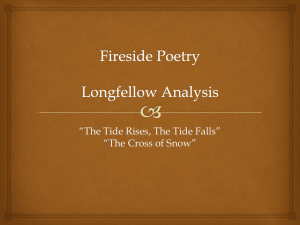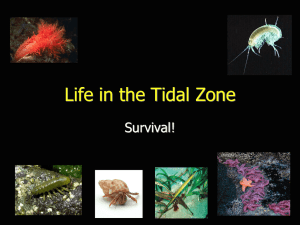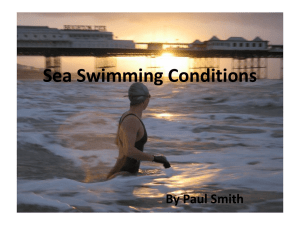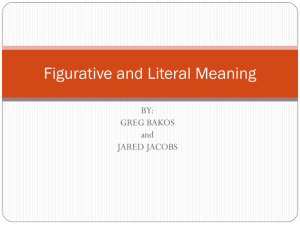TIDES_PPT3 notes
advertisement
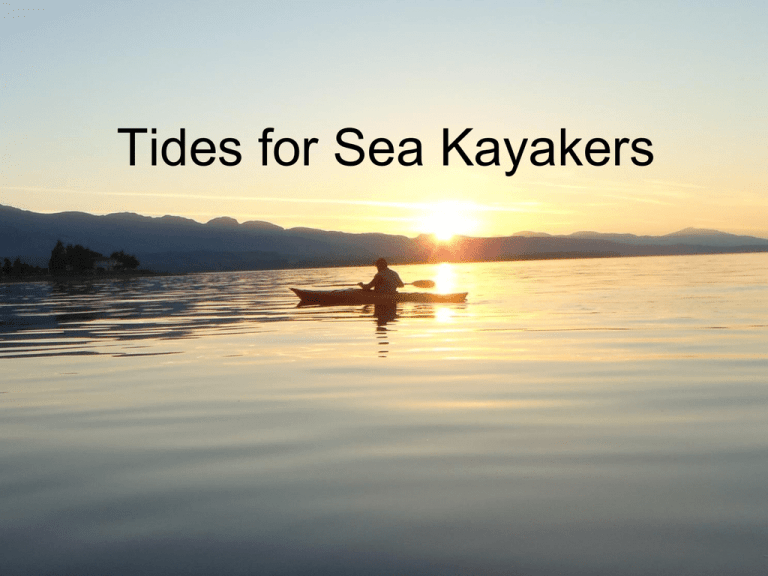
Tides for Sea Kayakers Overview • What is a Tide? • Types of Tides – Spring and Neap • High and Low Tides • Rule of Twelfths • Calculation of Tides at Secondary Ports • Calculation of Currents at Secondary Stations • Tide Races and Over falls • Tidal flow direction What is a Tide? Tides are the vertical rise and fall of the ocean level due to the gravitational and centrifugal forces between the earth and the moon and to a lesser extent the sun. High and Low Tide High tide is when the water stops rising (Also known as High Water). Low tide is when the tide stops dropping is Low Water or low tide Slack Water is when there is NO movement of water in either direction. Different Tidal Patterns Diurnal Tide Semi Diurnal Tide Mixed Tide Semi-diurnal Tidal Pattern In general in most of the world, the tides go up and down on a semi diurnal curve. A Semi-diurnal tide has two high tides and two low tides in a lunar day (24.8 hours). Diurnal Tidal Pattern A Diurnal tide is a tide with one low and one high tide in a lunar day (24.8 hours). Mixed Tidal Pattern Mixed tides are a diurnal and a semi-diurnal tide within the same geographic area. Mixed Semi-Diurnal Tides have two different ranges in tide levels Tidal Patterns For kayakers to remember: A Diurnal Tide has a 24 hour 50 min cycle. A Semi Diurnal Tide has a 12 hour 25 min cycle. Tidal Patterns Around the Earth Cause of different Tidal Patterns The Four Phases of the Moon Rule of Twelfths Consider the general rule of twelfths: The flow of water between low and high tide is divided into a 6 hour period. The first hour will move 1/12 of the total volume of the tide. The second hour will move 2/12. The third hour will move 3/12. The fourth will move 3/12. The fifth hour will move 2/12. And The sixth hour will move 1/12. As a result the middle two hours move roughly half of the tidal volume. TIDAL FLOW Tidal flow can be augmented by a number of factors: • Shallow water • Headlands • Constrictions • Wind direction Tidal Races and Overfalls Reading Tide Tables SECONDARY PORTS VANCOUVER VANCOUVER Day Time Feet Meters 5 0549 13.8 4.2 HIGHER HIGH WATER TIME DEEP COVE +0 30 LOWER LOW WATER MEAN TIDE LARGE TIDE TIME MEAN TIDE LARGE TIDE +0.2 +0.5 -0 06 +0.1 +0.5 1101 7.2 2.2 SA 1727 14.1 4.3 6 0010 REFERENCE PORTS 4.3 1.3 TABLE 2 0636 14.1 4.3 SU 1218 8.9 2.4 1757 14.1 4.3 HIGHER HIGH WATER VANCOUVER LOWER LOW WATER MEAN TIDE LARGE TIDE MEAN TIDE LARGE TIDE 14.4 16.5 3.6 -0.2 If we were to plan a paddle up Indian Arm launching at Deep Cove on Saturday October 5 when would it be a good time to launch? Reading Current Tables REFERENCE SECONDARY CURRENT STATIONS DODD NARROWS TABLE 4 (page 135) OCTOBER 2013 % REFERENCE RATE TIME DIFFERENCES TURNS TURN TO MAXIMUM TURN TO MAXIMUM FLOOD FLOOD FLOOD EBB EBB FALSE NARROWS +0 10 +0 25 +0 25 -0 35 50 EBB DAY MAXIMUM TIME TIME KNOTS 0043 +7.8 0358 0703 -6.6 1009 1251 +6.0 1544 1903 -7.0 55 19 You have to catch a Ferry back to the mainland at Departure Bay on October 19th and have to travel North though False Narrows, when would . you attempt this in a kayak? Hint: A Flood tide travels north through False Narrows – from marine chart. SA 2219 (page 97) Tide Take-aways • Know your tidal type (mixed, diurnal semi-diurnal) • Know when high and low tide occur • Know when neap and spring tides occur • Know the rule of twelfths for peak flow • Check the tidal tables before getting on the water • Be aware of tidal races and where they occur • Be aware of tidal directional flow and it’s variance around land masses THE END
